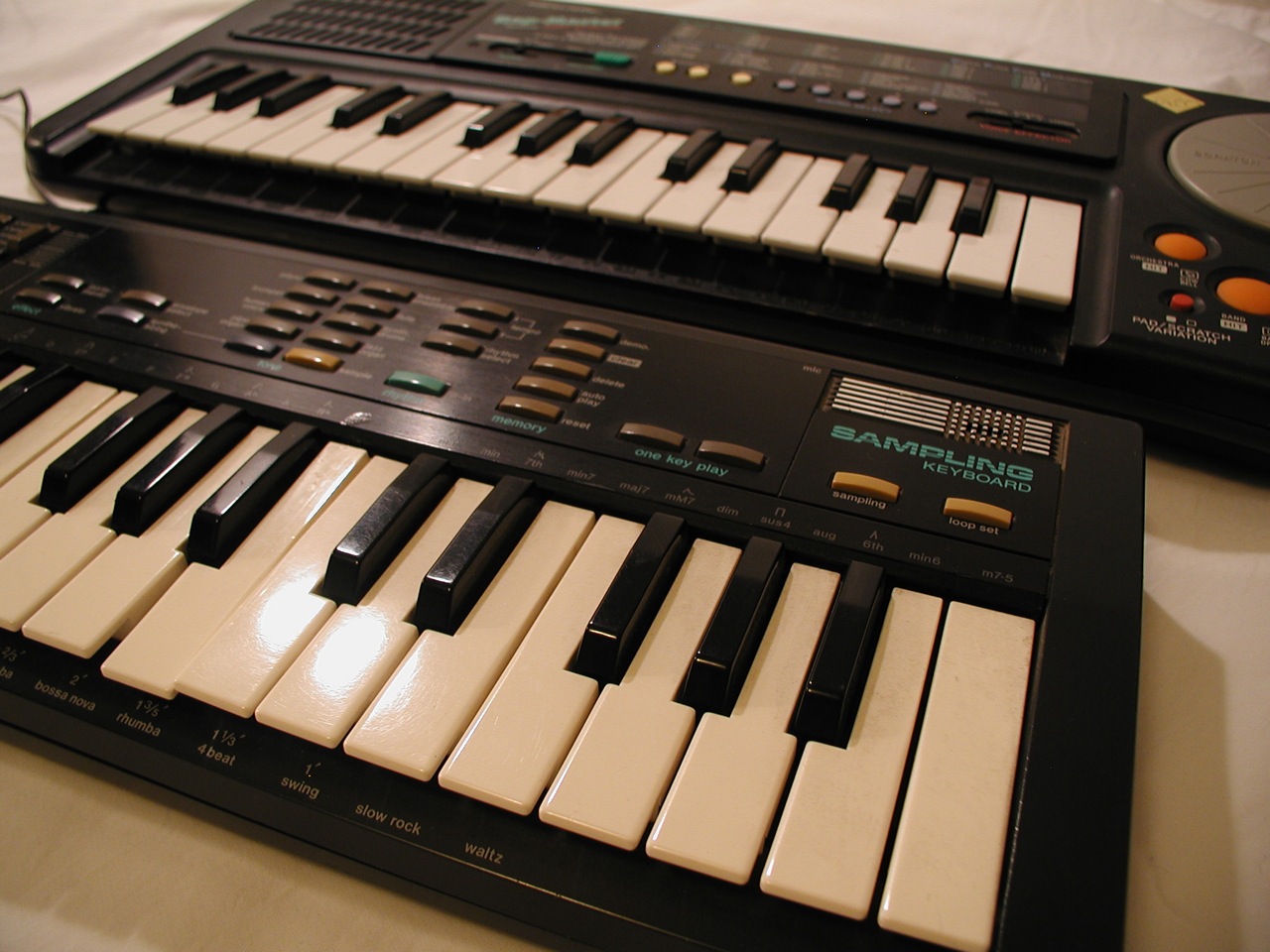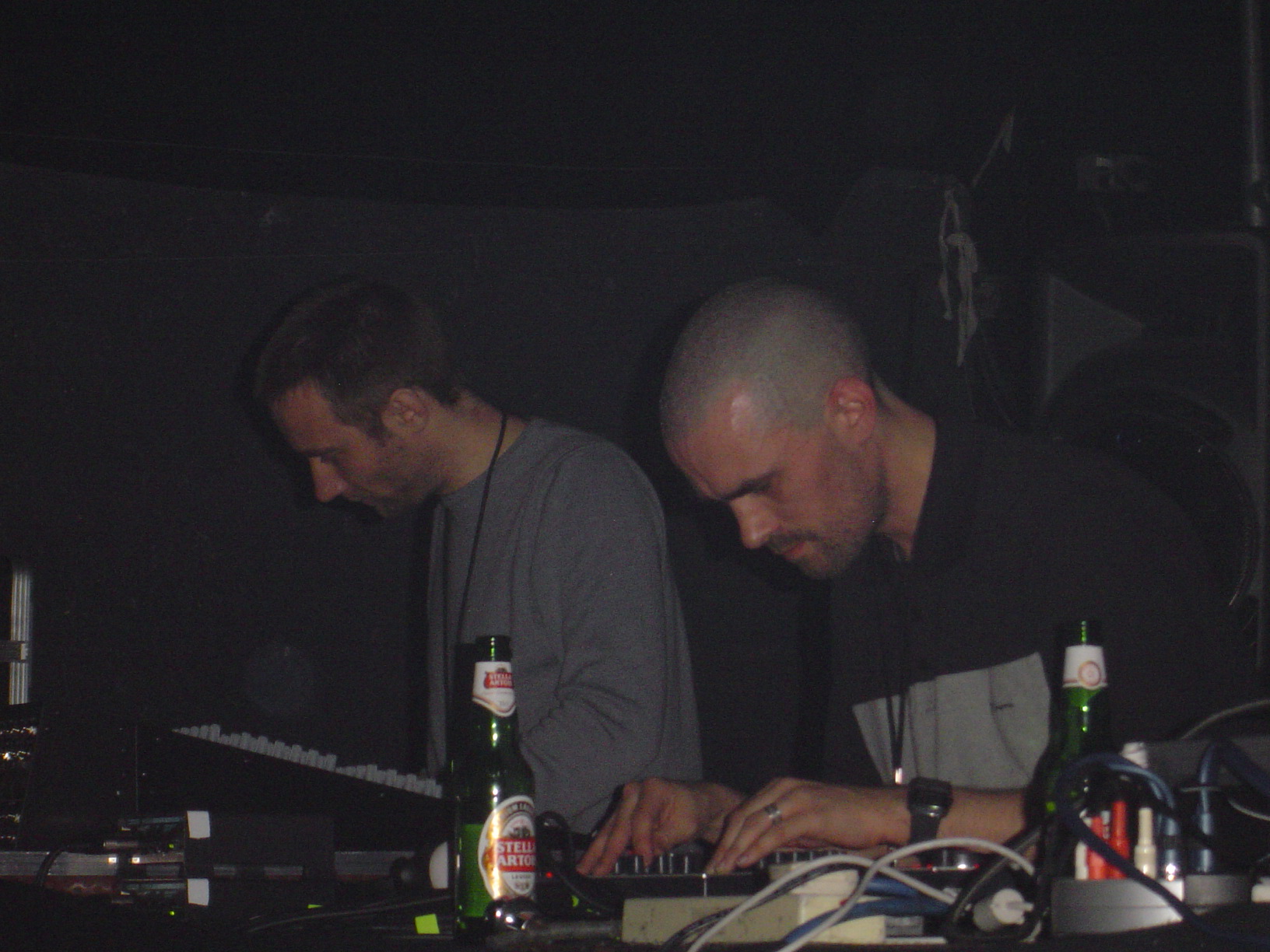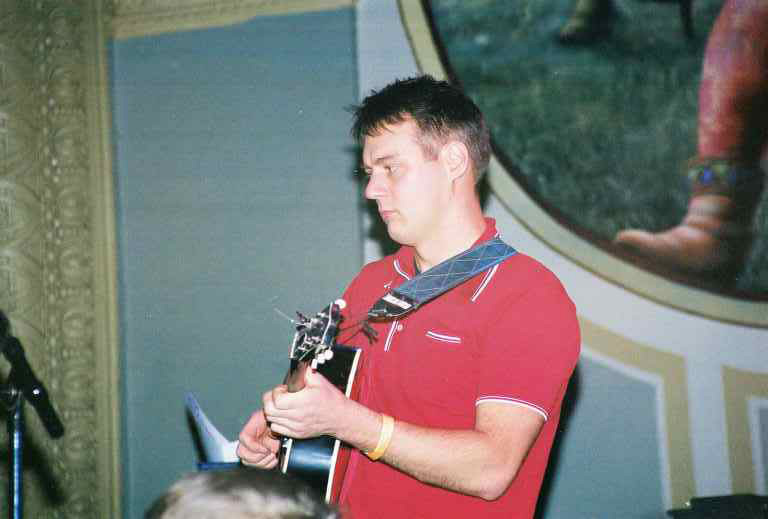|
Casio SK-1
The Casio SK-1 is a small sampling keyboard made by Casio in 1985. It has 32 small sized piano keys, four-note polyphony, with a sampling bit depth of 8 bit PCM and a sample rate of 9.38 kHz for 1.4 seconds, a built-in microphone and line level and microphone inputs for sampling, and an internal speaker and line out. It also features a small number of four-note polyphonic preset analog and digital instrument voices, and a simple additive voice. All voices may be shaped by 13 preset envelopes, portamento, and vibrato. It also includes a rudimentary sequence recorder, preset rhythms and chord accompaniment. The SK-1 was thus an unusually full-featured synth in the sub-US$100 (equivalent to $ today) home keyboard market of the time. The SK-1 includes one pre-arranged piece of music, the Toy Symphony, which is played when the "Demo" button is pressed. The Radio Shack version of the Casio SK-1 is called the Realistic Concertmate 500. The SK line continued throughout the late 1 ... [...More Info...] [...Related Items...] OR: [Wikipedia] [Google] [Baidu] |
Casio
is a Japanese multinational electronics manufacturing corporation headquartered in Shibuya, Tokyo, Japan. Its products include calculators, mobile phones, digital cameras, electronic musical instruments, and analogue and digital watches. It was founded in 1946, and in 1957 introduced the first entirely compact electronic calculator. It was an early digital camera innovator, and during the 1980s and 1990s, the company developed numerous affordable home electronic keyboards for musicians along with introducing the first mass-produced digital watches. History Casio was established as Kashio Seisakujo in April 1946 by (1917–1993), an engineer specializing in fabrication technology. Kashio's first major product was the yubiwa pipe, a finger ring that would hold a cigarette, allowing the wearer to smoke the cigarette down to its nub while also leaving the wearer's hands free. Japan was impoverished immediately following World War II, so cigarettes were valuable, and the inventi ... [...More Info...] [...Related Items...] OR: [Wikipedia] [Google] [Baidu] |
Vibrato
Vibrato (Italian language, Italian, from past participle of "wikt:vibrare, vibrare", to vibrate) is a musical effect consisting of a regular, pulsating change of pitch (music), pitch. It is used to add expression to vocal and instrumental music. Vibrato is typically characterized in terms of two factors: the amount of pitch variation ("extent of vibrato") and the speed with which the pitch is varied ("rate of vibrato"). In singing, it can occur spontaneously through variations in the larynx. The vibrato of a string instrument and wind instrument is an imitation of that vocal function. Vibrato can also be reproduced mechanically (Leslie speaker) or electronically as an Audio signal processing, audio effect close to Chorus (audio effect), chorus. Terminology History Descriptions of what would now be characterised as vibrato go back to the 16th century. However, no evidence exists of authors using the term vibrato before the 19th century. Instead, authors used various descrip ... [...More Info...] [...Related Items...] OR: [Wikipedia] [Google] [Baidu] |
Oldschool Jungle
Jungle is a genre of electronic music that developed in the 1990s out of the UK rave scene and Jamaican sound system culture. Emerging from breakbeat hardcore, the style is characterised by rapid breakbeats, heavily syncopated percussive loops, samples, and synthesised effects, combined with the deep basslines, melodies, and vocal samples found in dub, reggae and dancehall, as well as hip hop and funk. Many producers frequently sampled the "Amen break" or other breakbeats from funk and jazz recordings. Jungle was a direct precursor to the drum and bass genre which emerged in the mid-1990s. Origins The breakbeat hardcore scene of the early 1990s was beginning to fragment by 1992 and 1993, with different influences becoming less common together in tracks. The piano and uplifting vocal style that was prevalent in breakbeat hardcore started to lay down the foundations of 4-beat/happy hardcore, whilst tracks with dark-themed samples and industrial-style stabs had emerged from late ... [...More Info...] [...Related Items...] OR: [Wikipedia] [Google] [Baidu] |
Me And You And Everyone We Know
''Me and You and Everyone We Know'' is a 2005 Romance film, romantic comedy-drama film written and directed by Miranda July. She also acts in the starring role, opposite John Hawkes (actor), John Hawkes. The film was the first major studio production for July, who had been known previously for her self-produced short films and performance art. Plot The structure of the film consists of several subplots which all revolve around an intertwined cast of characters. Richard is a shoe salesman and recently separated father of two. After being thrown out by his wife Pam, he gets an apartment of his own to share with his sons, 14-year-old Peter and six-year-old Robby. He meets Christine, a senior-cab driver and amateur video artist, while she takes her client to shop for shoes, and the two develop a fledgling romantic relationship. Peter and Robby have a joint online chat, which Robby later depicts in another chat session as , an emoticon that means "pooping back and forth, forever." Th ... [...More Info...] [...Related Items...] OR: [Wikipedia] [Google] [Baidu] |
Michael Andrews (musician)
Michael Andrews (born November 17, 1967), also known as Elgin Park, is an American multi-instrumental musician, producer, and film score composer. He is best known for a cover version of the Tears for Fears song "Mad World", which he recorded with Gary Jules for the ''Donnie Darko'' soundtrack, and which became the 2003 UK Christmas number one. He is a founding member of the San Diego soul-jazz band The Greyboy Allstars, where he goes by the moniker Elgin Park. Soundtrack composing and production After joining The Greyboy Allstars following the dissolution of his band The Origin, Andrews fell into film score composition by chance in 1998 when The Greyboy Allstars were asked to score Jake Kasdan's first feature '' Zero Effect'' and worked on the music for the highly regarded (though short-lived) TV series, ''Freaks and Geeks''. In 2000, Richard Kelly commissioned him to do the soundtrack for the film ''Donnie Darko''. Its original score album went on to sell over 100,000 copie ... [...More Info...] [...Related Items...] OR: [Wikipedia] [Google] [Baidu] |
Autechre
Autechre ( ) are an English electronic music duo consisting of Rob Brown and Sean Booth, both from Rochdale, Greater Manchester. Formed in 1987, they are among the best known acts signed to UK electronic label Warp Records, through which all of Autechre's full-length albums have been released beginning with their 1993 debut '' Incunabula''. They gained initial recognition when they were featured on Warp's 1992 compilation ''Artificial Intelligence''. Influenced by styles such as 1980s electro and hip-hop, the music of Autechre has evolved throughout their career from early, melodic techno recordings to later works often considered abstract and experimental, featuring complex composition and few stylistic conventions. Their work has been associated with the 1990s electronic genre known as intelligent dance music (IDM), [...More Info...] [...Related Items...] OR: [Wikipedia] [Google] [Baidu] |
Keyboard Magazine
''Keyboard'' is a magazine that originally covered electronic keyboard instruments and keyboardists, though with the advent of computer-based recording and audio technology, they have added digital music technology to their regular coverage, including those not strictly pertaining to the keyboard-related instruments. The magazine has its headquarters in San Bruno, California. History and profile Future is the owner of ''Keyboard'' which was launched in 1975. During the initial years the magazine was named ''Contemporary Keyboard''. Over the years, the print and online editions of the magazine have moved into discussions on anything related to gear. The editors and writers of the magazine have covered historical information and stories on the development of keyboards from their inception with pioneers such as Moog Music. At times, editorial and guest articles in the magazine have covered subjects including music philosophy, keyboarding instruction, music theory, and harmonics. ... [...More Info...] [...Related Items...] OR: [Wikipedia] [Google] [Baidu] |
Reed Ghazala
Qubais Reed Ghazala (born September 20th 1953), is an American author, photographer, composer, musician and experimental instrument builder, was described by Motherboard as the "father of circuit bending", having discovered the technique in 1966, pioneered it, named it, and taught it ever since. Ghazala, who is from Cincinnati, Ohio, has built experimental instruments and/or consulted for many prominent musicians including Tom Waits, Peter Gabriel, King Crimson, and the Rolling Stones. Ghazala's work has been covered globally in the press including the ''New York Timess declaration of circuit-bending as part of the fine arts movement (April 8, 2004, Technology Section, Matthew Mirapaul), and can be found being taught world-wide. Ghazala's work is held in various galleries internationally including the permanent collections of New York City's Museum of Modern Art The Museum of Modern Art (MoMA) is an art museum located in Midtown Manhattan, New York City, on 53rd Street (Manh ... [...More Info...] [...Related Items...] OR: [Wikipedia] [Google] [Baidu] |
Circuit Bending
Circuit bending is the creative customization of the circuits within electronic devices such as children's toys and digital synthesizers to create new musical or visual instruments and sound generators. Circuit bending is manipulating a circuit to get an output that was not intended by the manufacturer. Emphasizing spontaneity and randomness, the techniques of circuit bending have been commonly associated with noise music, though many more conventional contemporary musicians and musical groups have been known to experiment with "bent" instruments. Circuit bending usually involves dismantling the machine and adding components such as switches and potentiometers that alter the circuit. Experimental process ] The process of circuit bending involves experimenting with inexpensive second-hand electronics that produce sounds, such as toys, keyboards, drum machines, and electronic learning products. Innovators While Ghazala says that he was not the first circuit bender, he coi ... [...More Info...] [...Related Items...] OR: [Wikipedia] [Google] [Baidu] |
Lo-fi Music
Lo-fi (also typeset as lofi or low-fi; short for low fidelity) is a music or production quality in which elements usually regarded as imperfections in the context of a recording or performance are present, sometimes as a deliberate stylistic choice. The standards of sound quality (fidelity) and music production have evolved over the decades, meaning that some older examples of lo-fi may not have been originally recognized as such. Lo-fi began to be recognized as a style of popular music in the 1990s, when it became alternately referred to as DIY music (from "do it yourself"). Some subsets of lo-fi music have become popular for their perceived nostalgic and/or relaxing qualities, which originate from the imperfections that define the genre. Traditionally, lo-fi has been characterized by the inclusion of elements normally viewed as undesirable in most professional contexts, such as misplayed notes, environmental interference, or phonographic imperfections (degraded audio signals, ... [...More Info...] [...Related Items...] OR: [Wikipedia] [Google] [Baidu] |
Realistic (brand)
Realistic was a private label consumer electronics brand produced by RadioShack. Initially only a home audio equipment brand, its product line expanded to include CB radios, walkie-talkies, and video camcorders by the 1980s. The brand was discontinued in 1994, but revived for a short time in 2016 for use on Bluetooth devices sold by the chain. History The brand began in 1954 after Radio Shack management were approached by stereo newcomer Harman Kardon, who offered to help create a line of private label audio equipment for the company. The original brand name, ''Realist'', was pitched by the manufacturer and approved by Radio Shack. The first Realist-branded products - an FM receiver, an AM receiver, and a matching 10-watt amplifier with a built-in preamp - were introduced later that year. These would be the only Realist-branded products, as the brand’s name was challenged by the David White Company, manufacturer of the Stereo Realist camera in 1955. The change to ''Realistic'' ... [...More Info...] [...Related Items...] OR: [Wikipedia] [Google] [Baidu] |





